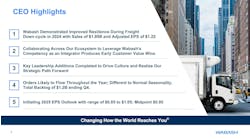Surviving the downturn - If a ‘return to normal’ is coming, increasing gross profit through improved processes is the best way to thrive
The commercial vehicle dealership industry is mature, making substantial expansion and investment challenging.
The total market isn’t getting much bigger, buyers are experienced—thanks in large part to the internet—prices are competitive, products aren’t highly differentiated—sorry manufacturers, but every trailer still basically is a box for hauling cargo—and attracting young talent is difficult, especially in a tight labor climate.
So when the good times—and recent times have been great for trailer manufacturers and dealers—eventually go away, or warning signs start to appear and a regression to mean feels inevitable, it can be difficult to stay positive.
And, says Alan Phibbs, it’s nearly impossible without the right approach.
“It’s all in how you look at it,” he said. “It’s an attitude.”
Phibbs is all about changing attitudes. The industry veteran spent eight years as an advisor with KEA Advisors, assisting commercial truck and trailer dealerships with all aspects of operations improvement and business planning, and now serves as the executive director of The John Maxwell Team, where he’s a DISC (Drive-Influence-Steadiness-Compliance)-certified speaker, trainer and coach, while still maintaining a CPA license.
He hosted a workshop during the 29th Annual National Trailer Dealers Association (NTDA) Convention aimed at helping dealers survive and thrive in any potential downturn by identifying ways to grow gross profit, even in an adverse environment, including reevaluating assets and expenses, pursuing non-traditional business opportunities, and growing value in personnel, service and a dealership’s reputation.
“If you change nothing, nothing will change,” Phibbs maintained.
Accounting 101
How do dealers make money? First, they need cash. Then they invest in inventory, reducing cash, work to sell that inventory, which turns into receivables, sometimes quickly, sometimes slowly, and eventually back into cash that pays expenses, hopefully leaving the dealership with more cash than it had previously, and repeat.
“It’s pretty basic stuff,” Phibbs said. “The problem is, when life is good we get sloppy at this. We get really sloppy, and we tend to take things for granted. What I know is this: the quicker you can turn your inventory into cash, the more value you’re going to get.”
Dealers should get old. Inventory shouldn’t, Phibbs joked. But how do we make sure the product on hand isn’t overstaying its welcome? Better asset management. “If it’s getting old and it’s losing value, get rid of it,” Phibbs pleaded. “It’s not doing you any good to hold it and hope you sell it sometime.”
Dealerships have stocking strategies. They also need exit strategies for parts and trailers, Phibbs said. They also should regularly reassess inventory integrity—is the part or trailer where it’s supposed to be?—shop scheduling—are hours of operation for employees or customers?—and pricing, especially in regard to discounts.
Examine expenses, and make sure they’re under control, especially the ones related to poor asset management, Phibbs advised. Considerations include commission structure, particularly in regard to minimum-commission deals on trailers sales—typically a byproduct of old inventory—adjustments, aka write-offs, warranty adjustments, unapplied time and bad debts. “Every single one of those expenses is directly related to asset management, and poor asset management is directly related to processes—without exception,” Phibbs said.
Unapplied time includes time wasted checking the shelf for parts. If time equals money, time saved equals money made. Adjustments include unintentional discounts, which are the enemy of profitable dealerships, Phibbs asserted, so stop allowing them. This is an easy way to increase price, and if the customer complains, compensate by making sure they understand the value of doing business with your dealership.
“Have your employees, in parts, sales and service, understand the value of doing business with your dealership,” Phibbs said. “Have you ever really taken the time to educate your staff on selling the value of doing business with our dealership?”
Price is what customers give. Value is what they receive. So the dealer’s job is to make sure they believe what they are receiving is worth more than what they are giving. Some customers may home in on prices, and say they’re too high compared to the local competitor. Is that true? Call the competitor and find out. Who gave them that price? Does the customer have authority to buy elsewhere? Figure it out.
The four main factors in everyone’s buying decisions are quality, convenience, service and price, and Phibbs says time trumps price almost every time. “I don’t care if you are the cheapest, if you can’t get a trailer in and out, they’re not going to do business with you,” he said. “If you don’t have what the customer needs, they’re going to Down-the-Road Motors.”
Changing minds
Reducing costs and increasing prices through better asset management boosts gross profit. So does selling more products and services to new and existing customers. What is the customer’s budget? Don’t know? Find out and do the math. Are they buying from somebody else, too? Why? Probably because of time. “The best value you can put into your business is time,” Phibbs said. “Figure out the time interval and you’ll win every time.”
Dealers don’t sell parts or trailers. They sell solutions that solve customer problems. And no one likes to be sold, so figure out what the customer’s need is, build that relationship, and help them buy.
Think outside the box. Traditional business opportunities include customers entering a market and competitors exiting. Non-traditional opportunities include a trailer dealer offering truck services, or working on box trucks, which are similar to trailers, selling parts to customers outside the market who need similar parts, and refinancing sold equipment.
Finally, look at personnel. Everyone’s different, but predictably so, so discover what makes them tick and find a way to relate, which increases your influence over them, and leadership is all about influence, Phibbs said. “Keep your personnel going,” he advised. “Let them know what your expectations are, let them know how they’re doing, keep them happy, and your customers will be happy. I can promise you if you have unhappy employees, you have unhappy customers.”
Make them happy by giving them what they want. Often, it’s simply recognition, so recognize an employee for doing a good job, even if it’s “what they’re supposed to do.” Younger generations want empathy, not sympathy, and an employer who’s more like a parent than a task master, and willing to groom them for the future.
Bottom line: Employees should be viewed as an asset, not an expense. “What do you expect from your assets?” Phibbs said. “To get a return. So this is a change in mindset. I’m not talking about a change in accounting. View your employees as an asset on your balance sheet you expect to get a return. You can only get a return if you view them as an investment.”










